Why is the Standard for Information Security Management System being updated?
According to a recent report, more and more businesses rely on digital services for back-office and customer-facing activities. Digital threats to information security are also evolving. The ISO 27001 revision includes updates that reflect modern business practices, while ensuring organisations remain competitive.
Key Benefits to this Transition
The new ISO 27001:2022 standard introduces important updates which help streamline compliance and address today’s information security challenges.
Enhanced Security Posture. The 2022 version includes updated controls to address modern threats such as cloud security, data privacy, and supply chain risks.
Improved Risk Management. A more robust risk-based approach helps organisations to prioritise and mitigate security risks.
Regulatory Compliance. Staying aligned with the latest standard ensures compliance with various industry regulations and legal requirements.
Business Continuity. A strong ISMS helps maintain business operations during incidents and disruptions.
Customer Trust. Demonstrating commitment to information security can enhance client/customer trust and loyalty.

Understand the Risks of missing the Transition deadline
Cybersecurity threats are evolving all the time. More businesses have moved towards cloud computing and embraced digital transformation, which has the potential to uncover new vulnerabilities for attackers to exploit.
As mentioned above, the updated controls in ISO/IEC 27001:2022 specifically address these risks, including enhanced security for cloud environments, data privacy, and emerging technologies.
Also, non-compliance can be costly. Companies who have not transitioned will discover that their certificates expire on 31st October 2025. This could cause compliance issues and contractual issues, which may result in fines, loss of business, or legal consequences.
Guidelines for a Smooth Transition
Assess Your Current ISMS. Evaluate your existing ISMS against the 2022 standard’s requirements. Identify any gaps and areas for improvement. It may be worth considering using a gap analysis tool to streamline this process.
Understand the Changes. Familiarise yourself with the key changes in the 2022 version, including the new controls for emerging threats; increased focus on risk management and the streamlined requirements. It may be worth consulting with experts or certification bodies for guidance.
Create a Transition Plan. Develop a detailed plan outlining the steps, timelines, and key responsibilities. Allocate resources and budget for the transition. Consider training and awareness programs for employees.
Update Your Documentation. Review and update your ISMS documentation, including policies, procedures, and records. Ensure your organisation’s system aligns with the 2022 standard’s requirements.
Implement Controls. Implement the necessary controls to address the gaps identified in the assessment. It may be worth using technological solutions to automate certain processes.
Conduct Internal Audits. Perform regular internal audits to monitor compliance and identify areas for improvement. Use the audit findings to refine your organisation’s ISMS.
Strengthen your organisation’s Information Security Posture
Do what you can to secure buy-in and support from senior management and employees. Focus on addressing high-risk areas first. Ensure you leverage technology tools to automate tasks and improve efficiency. Keep up to date with the latest information security trends and best practices. Finally, regularly review your ISMS periodically. By following these guidelines, organisations can successfully transition to ISO/IEC 27001:2022.








